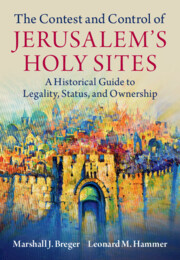440 results
5 - The Right World
-
- Book:
- World of the Right
- Print publication:
- 27 June 2024, pp 144-182
-
- Chapter
- Export citation
Beyond retribution: Individual reparations for IHL violations as peace facilitators
-
- Journal:
- International Review of the Red Cross , First View
- Published online by Cambridge University Press:
- 10 May 2024, pp. 1-20
-
- Article
- Export citation
23 - Gesture and Intersubjectivity
- from Part V - Gestures in Relation to Interaction
-
-
- Book:
- The Cambridge Handbook of Gesture Studies
- Published online:
- 01 May 2024
- Print publication:
- 18 April 2024, pp 599-615
-
- Chapter
- Export citation
Introduction - Time, Recognition, and the Worlds of Yeats’s Work
-
- Book:
- Yeats, Revival, and the Temporalities of Irish Modernism
- Published online:
- 11 April 2024
- Print publication:
- 18 April 2024, pp 1-23
-
- Chapter
- Export citation
Beyond Expropriation Without Compensation
- from Introduction
-
-
- Book:
- Beyond Expropriation Without Compensation
- Published online:
- 28 March 2024
- Print publication:
- 04 April 2024, pp 3-32
-
- Chapter
-
- You have access
- Open access
- HTML
- Export citation
10 - Social Justice or Sexual Justice?
-
-
- Book:
- Social Justice in Twentieth-Century Europe
- Published online:
- 29 February 2024
- Print publication:
- 07 March 2024, pp 205-223
-
- Chapter
- Export citation
6 - Classed and Gendered Experiences of Precarity in Dirty Work
-
-
- Book:
- Diversity and Precarious Work During Socio-Economic Upheaval
- Published online:
- 01 February 2024
- Print publication:
- 08 February 2024, pp 99-118
-
- Chapter
- Export citation
Chapter 17 - The Health Aspects of Epidemics and Pandemics
- from Section 2 - Clinical Aspects of Traumatic Injuries, Epidemics, and Pandemics
-
-
- Book:
- Major Incidents, Pandemics and Mental Health
- Published online:
- 11 January 2024
- Print publication:
- 01 February 2024, pp 118-125
-
- Chapter
- Export citation
10 - First Generation of American Humboldtians of the Early Nineteenth Century
- from Part IV - Wilhelm von Humboldt’s Impact on Americanist Linguistics and Anthropology
-
- Book:
- Wilhelm von Humboldt and Early American Linguistics
- Published online:
- 11 January 2024
- Print publication:
- 01 February 2024, pp 195-222
-
- Chapter
- Export citation
5 - The Issuer of a Collective Self-Defence Request
-
- Book:
- Collective Self-Defence in International Law
- Published online:
- 04 January 2024
- Print publication:
- 25 January 2024, pp 169-203
-
- Chapter
- Export citation
9 - Objective and Subjective Dimensions of Meaningful Waged Work
- from Part III - Meaningful and Meaningless Waged Work
-
- Book:
- The Politics of Working Life and Meaningful Waged Work
- Published online:
- 02 November 2023
- Print publication:
- 16 November 2023, pp 179-230
-
- Chapter
- Export citation
9 - Consent to Intervention and Intervention in Civil Wars
- from Part IV - Forcible Intervention in Situations of Civil Unrest
-
- Book:
- The Use of Force and International Law
- Published online:
- 26 October 2023
- Print publication:
- 09 November 2023, pp 445-485
-
- Chapter
- Export citation
3 - The Origin of Constitutions
- from Part I - Constitutional Diffusion
-
- Book:
- The Story of Constitutions
- Published online:
- 19 October 2023
- Print publication:
- 02 November 2023, pp 44-68
-
- Chapter
- Export citation
Humanism: A Reconsideration
-
- Journal:
- Journal of the American Philosophical Association , First View
- Published online by Cambridge University Press:
- 23 October 2023, pp. 1-20
-
- Article
- Export citation
6 - Science as a Social Endeavor
-
- Book:
- The Philosophy and Practice of Science
- Published online:
- 17 September 2023
- Print publication:
- 31 August 2023, pp 302-346
-
- Chapter
- Export citation
4 - The Politics of Tragedy, Recognition, and Acknowledgment
-
- Book:
- Stanley Cavell's Democratic Perfectionism
- Published online:
- 17 August 2023
- Print publication:
- 31 August 2023, pp 132-167
-
- Chapter
- Export citation

The Contest and Control of Jerusalem's Holy Sites
- A Historical Guide to Legality, Status, and Ownership
-
- Published online:
- 27 July 2023
- Print publication:
- 17 August 2023
Chapter 9 - Recognition Theory and Moral Education
- from Part II - New Approaches to Moral Education
-
-
- Book:
- Moral Education in the 21st Century
- Published online:
- 01 June 2023
- Print publication:
- 15 June 2023, pp 151-170
-
- Chapter
- Export citation
Chapter 5 - The Transcendental Deduction
-
- Book:
- Heidegger's Interpretation of Kant
- Published online:
- 01 June 2023
- Print publication:
- 15 June 2023, pp 133-159
-
- Chapter
- Export citation
The costs of recognition: global politics, religion, and the colonial history of South Asia
-
- Journal:
- International Theory / Volume 15 / Issue 2 / July 2023
- Published online by Cambridge University Press:
- 13 June 2023, pp. 323-350
-
- Article
- Export citation



